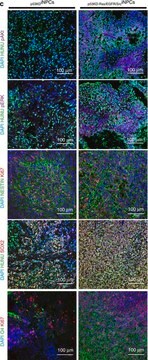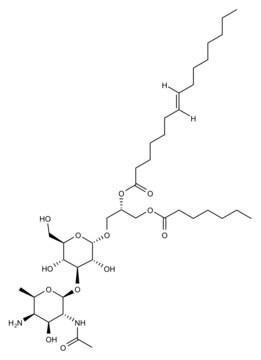MAB5606Z
Anti-GD1a Ganglioside Antibody, clone GD1a-1 (Azide Free)
clone GD1a-1, from mouse
Sinónimos:
GD1a Ganglioside
About This Item
Productos recomendados
biological source
mouse
Quality Level
antibody form
purified immunoglobulin
antibody product type
primary antibodies
clone
GD1a-1, monoclonal
species reactivity
bovine, human, fish, mouse, rat
species reactivity (predicted by homology)
vertebrates (based on 100% sequence homology)
technique(s)
ELISA: suitable
immunohistochemistry: suitable (paraffin)
isotype
IgG1κ
shipped in
dry ice
target post-translational modification
unmodified
General description
Specificity
Immunogen
Application
ELISA Analysis: Target specificity of a representative lot was determined by ELISA analysis (Gong, Y., et al. (2002). Brain. 125(Pt 11):2491-2506).
Immunohistochemistry Analysis: A representative lot detected GD1a immunoreactivity in fresh-frozenmid-sagittal brain sections from wild-type and St3gal2/3-double-null mice (Sturgill, E.R., et al. (2012). Glycobiology.22(10):1289-1301).
Immunohistochemistry Analysis: A representative lot detected GD1a immunoreactivity in various fish brain regions using free-floating sections (Viljetić, B., et al. (2012). Biochim Biophys Acta. 1820(9):1437-1443).
Immunohistochemistry Analysis: A representative lot detected GD1a in fresh-frozen human and rat brain sections by both fluorescent and non-fluorescent immunohistochemistry (Gong, Y., et al. (2002). Brain. 125(Pt 11):2491-2506).
Immuno-overlay Assay: A representative lot detected bovine brain GD1a, as well as GD1a in human ventral and dorsal root gangliosides extracts (Gong, Y., et al. (2002). Brain. 125(Pt 11):2491-2506).
Neuroscience
Developmental Neuroscience
Quality
Immunohistochemistry Analysis: A 1:50 dilution of this antibody detected GD1a Ganglioside in human heart tissue.
Linkage
Physical form
Storage and Stability
Handling Recommendations: Upon receipt and prior to removing the cap, centrifuge the vial and gently mix the solution. Aliquot into microcentrifuge tubes and store at -20°C. Avoid repeated freeze/thaw cycles, which may damage IgG and affect product performance.
Other Notes
Disclaimer
¿No encuentra el producto adecuado?
Pruebe nuestro Herramienta de selección de productos.
Storage Class
12 - Non Combustible Liquids
wgk_germany
WGK 1
flash_point_f
Not applicable
flash_point_c
Not applicable
Certificados de análisis (COA)
Busque Certificados de análisis (COA) introduciendo el número de lote del producto. Los números de lote se encuentran en la etiqueta del producto después de las palabras «Lot» o «Batch»
¿Ya tiene este producto?
Encuentre la documentación para los productos que ha comprado recientemente en la Biblioteca de documentos.
Nuestro equipo de científicos tiene experiencia en todas las áreas de investigación: Ciencias de la vida, Ciencia de los materiales, Síntesis química, Cromatografía, Analítica y muchas otras.
Póngase en contacto con el Servicio técnico






